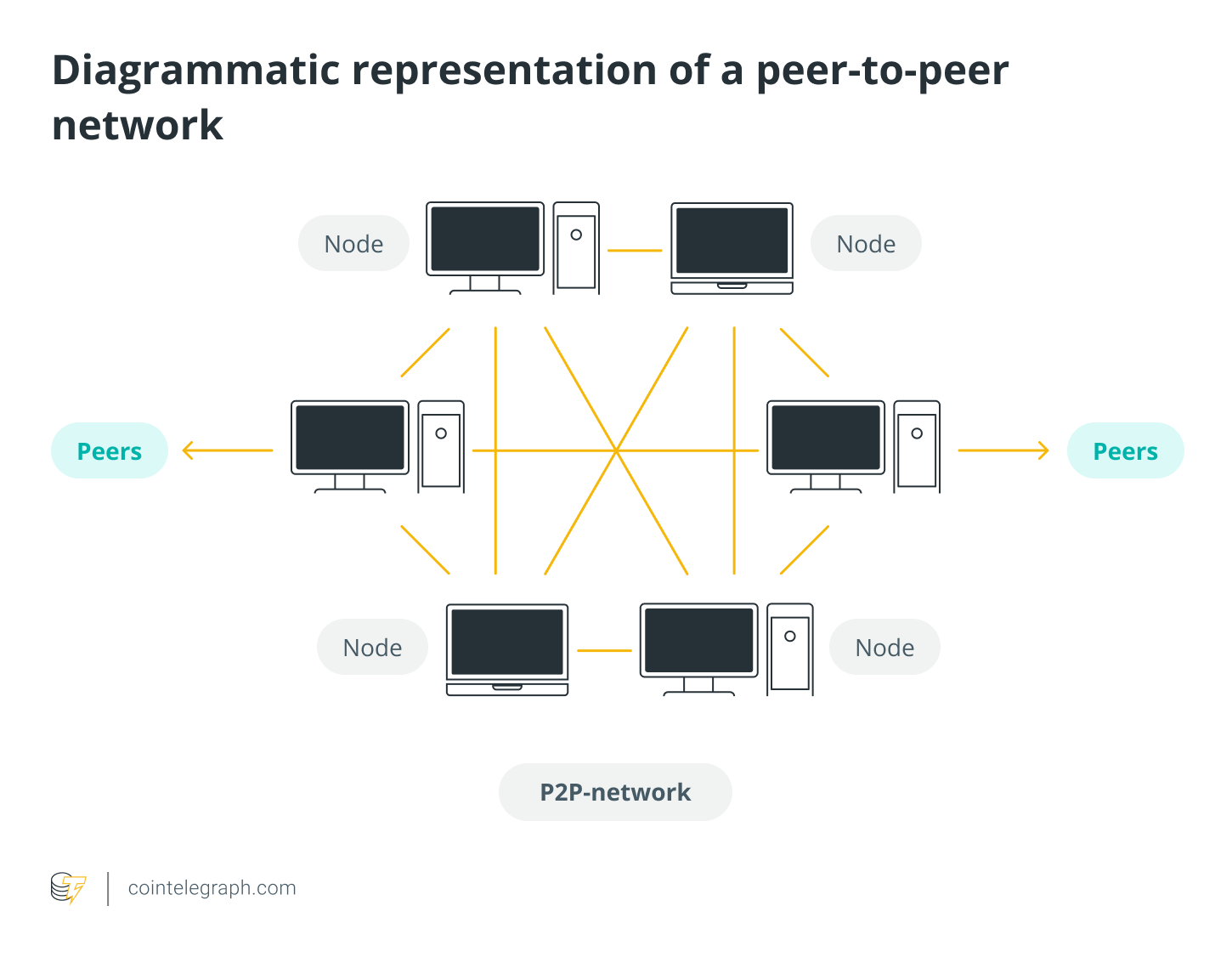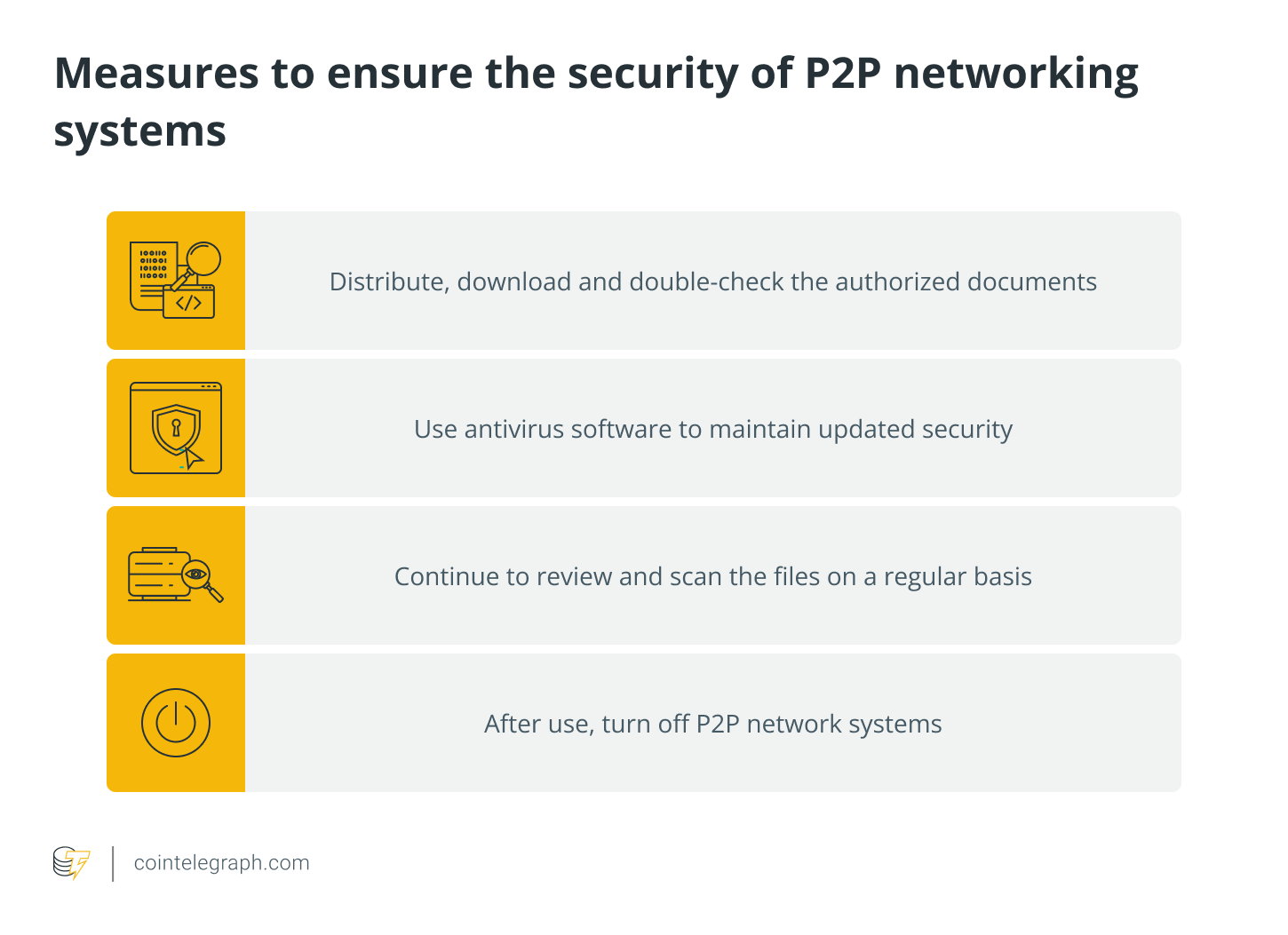What are peer-to-peer (P2P) networks?
Peer-to-Peer (P2P) technology is based on the decentralization concept, which lets network participants conduct transactions without needing any middle-man, intermediaries or central server. Peer-to-peer technology is how Bitcoin (BTC) operates; no administrator is required to maintain track of user transactions on the network. Instead, the peers in the network cooperate to handle deals and manage the BTC.
Peers refer to the nodes or computers that perform the same tasks and have the same power within a blockchain network. Blockchain is a P2P network that acts as a decentralized ledger for one or more digital assets, which refers to a decentralized peer-to-peer system where each computer keeps a complete copy of the ledger and verifies its authenticity with other nodes to guarantee the data is accurate. In contrast, transactions at a bank are kept secret and are only overseen by the bank.
The security of the underlying consensus algorithms and the privacy of transactions are all closely tied to its implementation, making the P2P network a crucial component of blockchains. However, no common P2P protocol for blockchains has been suggested. Instead, different cryptocurrencies have developed and adapted their own peer-to-peer protocols.
How do P2P networks work?
As mentioned, there are no central in peer-to-peer blockchain networks. Instead, all nodes (peers) are connected to one another. A mesh network with a “flat” topology connects the network nodes and there is no hierarchy. In a peer-to-peer network, nodes simultaneously give and consume services with reciprocity serving as the motivation for participation, making P2P networks open, decentralized and robust by nature.

Each node on the network must serve as both a client and a server to other nodes in a P2P network, making it distinct from a traditional client-server setup. There is always a central server in a client-server configuration from which the client downloads files.
On the contrary, in a decentralized setup, each node acts as a server that can download files and share them with other nodes. A node may perform both the sharing and receiving functions concurrently, which accounts for the P2P network's speed, security and efficiency. The measures listed below can help to ensure the security of your P2P networking systems:

Furthermore, in order for new peers joining the network to readily locate other peers to connect to, P2P architecture functions best when there are many active peers in a blockchain network. It is important to note that there are still enough peers left in the network to pick up the slack if a significant number of peers leave.
However, there are fewer resources accessible overall when there are few peers. For instance, with a P2P file-sharing application, a file might be downloaded more quickly if it is popular, which indicates that many peers are sharing it.
What are the various types of peer-to-peer (P2P) networks?
A P2P architecture can be categorized into structured, unstructured and hybrid peer-to-peer networks, as explained below.
Structured peer-to-peer networks
In this type of network, nodes interact based on an organized structure, enabling nodes to precisely search for files, even if the content is unavailable. However, due to an organized system, some sort of centralization exists in structured P2P networks. Unlike unstructured peer-to-peer networks, structured peer-to-peer networks are challenging to set up, although they provide simple data access.
Unstructured peer-to-peer networks
There is no set structure for the nodes in this kind of network, allowing network participants to join or leave the network as they desire. Also, due to a lack of definite structure, participants converse with one another at random. However, unstructured P2P networks require all nodes to remain active to power a high number of transactions, mandating huge CPU power to ensure that the network runs properly.
Hybrid peer-to-peer networks
This type of P2P network mixes some P2P design aspects with the traditional client-server approach. For example, it makes it possible to locate a node using the central server. A distributed network application framework called the client-server architecture assigns tasks to servers and clients in the same system that connect via a computer network or the Internet.
Benefits of P2P blockchain networks
Peer-to-peer networks offer many benefits over the traditional client-server architecture as there is no single point of failure in a distributed network of computers. On the other hand, data may get erased if the server goes down in a client-server model. Moreover, P2P networks may withstand attacks reasonably well since they are decentralized and lack a centralized server. Unlike banks, blockchains using P2P architecture cannot restrict network participants from doing a transaction.
In addition, P2P networks are cost-effective because they do not require a network operating system, thus reducing costs. Furthermore, peer-to-peer networks are remarkably resilient to changes in peer composition — the network can readily accommodate an increase in load if many new peers join it at once. Also, the loss of a single peer has little effect on the network as a whole.
Various use cases of P2P blockchain networks include sharing software and games through file-sharing networks. Cryptocurrencies also use P2P networks to allow users to conduct transactions in a decentralized setup. Other than the Bitcoin network, Skype and BitTorrent are P2P network examples.
Limitations of P2P blockchain networks
Despite the above advantages, peer-to-peer networks are not without any cons. As there is no centralized server, any virus or malware may get injected into all the participating nodes from the infected one. Similarly, nodes can distribute copyrighted content as no centralized party controls the system.
Additionally, anyone can create parallel networks called a hard fork of the blockchain if they want, implying that the software needs to be updated to comply with the new guidelines. For instance, following the Ethereum Merge, proof-of-work Ethereum (ETHW) was created by a Chinese miner.
P2P networks frequently have a sizable number of users who consume the resources shared by other nodes while keeping their own resources to themselves. Such free-riding nodes are called “leechers” that may support unethical and immoral behavior.
Is P2P crypto trading safe?
Peer-to-peer trading allows buyers and sellers to trade directly on decentralized exchanges (DEXs). P2P cryptocurrency exchanges give users more control over prices and payment options. Nonetheless, this freedom comes at the cost of decreased liquidity compared to traditional exchanges, restricting the range of cryptocurrencies that may be traded at peer-to-peer marketplaces like Binance.
No involvement of the third party, zero transaction costs and flexible prices make P2P crypto trading attractive to cryptocurrency traders. However, many nations aim to outlaw the trading and transaction of cryptocurrencies in response to governments worldwide trying to control the cash flow surrounding digital currencies and influence the crypto markets.
Since P2P crypto marketplaces trade on a worldwide market while remaining local, they can get around these cryptocurrencies-related regulations. Additionally, all transactions on a peer-to-peer network are protected by escrow smart contracts, preventing fraud against either party involved in P2P trades.
Related: What is P2P trading, and how does it work in peer-to-peer crypto exchanges?
Tokens are transferred to the escrow, a third-party smart contract, before a transaction is made. Until the necessary payment conditions are met, the escrow retains the tokens that have been deposited. However, the parties to the transaction must ensure that the agreed-upon good or service is provided and that money is received.
Despite such safety measures, P2P trading is not entirely safe. For instance, using the chargeback feature (return of money to the payer) of P2P payment platforms, scammers may request the payment back. Therefore, conducting due diligence on P2P marketplaces may protect you against peer-to-peer trading scams
That said, watch out for unusual behavior and avoid canceling the trade after paying because the cryptocurrency will be freed from the escrow service and returned to the seller's wallet. Instead, designate the transaction as paid and use the proof of payment to claim any money back.
Disclaimer : The above empty space does not represent the position of this platform. If the content of the article is not logical or has irregularities, please submit feedback and we will delete or correct it, thank you!